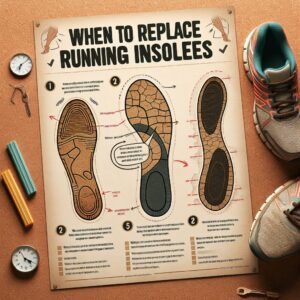-
Table of Contents
The frequency of changing insoles in work boots depends on various factors such as the intensity of use, the quality of the insole, and the user’s comfort level. Typically, it is recommended to replace insoles every six to twelve months. However, for those who use their work boots more intensively, the insoles may need to be replaced more frequently. This article will delve into the specifics of when and why you should consider changing the insoles in your work boots.
Decoding the Lifespan of Insoles in Work Boots: When to Change?
Insoles in work boots play a pivotal role in providing comfort, support, and shock absorption, thereby reducing the risk of foot injuries and discomfort. However, like any other component of your footwear, insoles are not designed to last forever. Over time, they wear out and lose their effectiveness, necessitating replacement. The question that arises then is, how often should one change the insoles in work boots?
The lifespan of insoles in work boots is influenced by several factors. The frequency of use, the type of work environment, the quality of the insoles, and the individual’s foot health are all determinants of how long the insoles will last.
For individuals who wear their work boots daily and are engaged in physically demanding jobs, the insoles may need to be replaced more frequently. This is because the constant pressure and friction can cause the insoles to wear out faster. On the other hand, if the work boots are used less frequently or in less strenuous conditions, the insoles may last longer.
The quality of the insoles also plays a significant role in determining their lifespan. High-quality insoles, made from durable materials, are designed to withstand wear and tear for a longer period. However, even the best quality insoles will eventually need to be replaced.
Foot health is another factor to consider. Individuals with specific foot conditions, such as flat feet or plantar fasciitis, may need to change their insoles more frequently. This is because these conditions often require more support and cushioning, which can cause the insoles to wear out faster.
Given these variables, it’s challenging to provide a definitive timeline for when to change the insoles in work boots. However, a general rule of thumb is to replace them every six to twelve months. This timeframe is a guideline and should be adjusted based on the factors mentioned earlier.
It’s also essential to pay attention to signs that your insoles need to be replaced. If you start to notice that your feet are more tired or sore than usual at the end of the day, it could be a sign that your insoles are worn out. Other indicators include visible signs of wear and tear, such as thinning, cracking, or flattening of the insoles, or if the insoles no longer fit snugly in your boots.
In conclusion, the frequency of changing the insoles in work boots depends on several factors, including the frequency of use, work environment, quality of the insoles, and individual foot health. As a general guideline, consider replacing your insoles every six to twelve months, but adjust this timeframe based on your specific circumstances. Paying attention to signs of wear and tear and changes in foot comfort can also help you determine when it’s time to replace your insoles. Remember, maintaining the quality of your insoles is not just about comfort; it’s also about ensuring the health and safety of your feet.
The Importance of Regularly Changing Insoles in Work Boots
The importance of regularly changing insoles in work boots cannot be overstated. This seemingly minor detail can significantly impact the comfort, safety, and overall health of individuals who spend long hours on their feet. Insoles play a crucial role in providing support, absorbing shock, and reducing pressure on the feet. However, over time, they can wear out and lose their effectiveness, leading to discomfort and potential foot problems. Therefore, understanding when to replace them is essential.
The frequency of changing insoles in work boots largely depends on several factors. These include the quality of the insoles, the intensity of use, and the individual’s foot health. High-quality insoles tend to last longer, but even the best ones need to be replaced eventually. If the boots are worn daily under strenuous conditions, the insoles may need to be changed more frequently. Similarly, individuals with specific foot conditions may require more frequent changes to maintain optimal foot health.
Typically, it is recommended to replace insoles every three to six months. However, this is a general guideline and may not apply to everyone. Some people may find that their insoles last longer, while others may need to replace them more frequently. It is crucial to pay attention to the signs that indicate it’s time for a change. These signs can include visible wear and tear, a noticeable decrease in comfort, or the onset of foot pain or discomfort.
When insoles start to wear out, they lose their ability to provide adequate support and cushioning. This can lead to increased pressure on the feet, which can cause discomfort and potentially lead to foot problems. Moreover, worn-out insoles can also compromise the fit of the boots, which can affect stability and increase the risk of slips and falls. Therefore, regularly changing insoles is not just about maintaining comfort, but also about ensuring safety.
In addition to the frequency of use and the quality of the insoles, personal foot health also plays a significant role in determining when to replace insoles. Individuals with specific foot conditions, such as flat feet or plantar fasciitis, may need to change their insoles more frequently. This is because these conditions often require more support and cushioning, which can wear out the insoles faster. Therefore, individuals with foot conditions should monitor their insoles closely and replace them as needed to maintain optimal foot health.
In conclusion, regularly changing insoles in work boots is a crucial aspect of foot health and safety. While the general guideline is to replace insoles every three to six months, individual factors such as the intensity of use, the quality of the insoles, and personal foot health can influence this timeline. Therefore, it is essential to pay attention to the signs that indicate it’s time for a change and to replace insoles as needed. By doing so, individuals can ensure that their work boots continue to provide the support, comfort, and safety they need.
Understanding the Right Time to Replace Insoles in Work Boots
Insoles in work boots play a crucial role in providing comfort, support, and shock absorption, thereby reducing the risk of foot injuries and discomfort. However, like any other part of the boot, insoles are subject to wear and tear and will eventually need to be replaced. Understanding the right time to replace insoles in work boots is essential to maintain optimal foot health and comfort.
Typically, the lifespan of insoles depends on several factors, including the quality of the insole, the frequency of use, and the type of work or activity performed. High-quality insoles made from durable materials can last anywhere from six months to a year, while less expensive insoles may need to be replaced every three to six months. If the boots are worn daily for heavy-duty work or long hours, the insoles may wear out faster due to the increased pressure and friction.
One of the most apparent signs that it’s time to replace your insoles is when they start to show visible signs of wear and tear. This could include thinning, cracking, or tearing of the material, or a flattened or distorted shape. If the insole no longer fits snugly in the boot or moves around when walking, it’s likely time for a replacement.
In addition to visible signs, changes in comfort level and foot health can also indicate the need for new insoles. If you start to experience increased foot fatigue, discomfort, or pain after wearing your boots, it could be a sign that the insoles are no longer providing adequate support and cushioning. Similarly, the development of foot conditions such as blisters, calluses, or plantar fasciitis could be a sign that the insoles are not functioning as they should.
It’s also worth noting that even if the insoles appear to be in good condition and you’re not experiencing any discomfort, they may still need to be replaced. Over time, insoles can lose their effectiveness in absorbing shock and providing support, even if they don’t show visible signs of wear. Therefore, it’s a good practice to replace insoles regularly as a preventative measure, even if they seem to be holding up well.
In conclusion, the frequency of changing insoles in work boots largely depends on the quality of the insoles, the intensity of use, and individual comfort and foot health. Visible wear and tear, decreased comfort, and the development of foot conditions are all signs that it’s time to replace your insoles. However, as a rule of thumb, consider replacing your insoles every six to twelve months, or sooner if necessary, to ensure optimal foot health and comfort. Remember, your feet carry the weight of your entire body, and taking care of them is an investment in your overall health and well-being.In conclusion, the frequency of changing insoles in work boots depends on the intensity of use and the quality of the insole. However, as a general rule, it is recommended to replace them every six to twelve months for optimal comfort and support.







